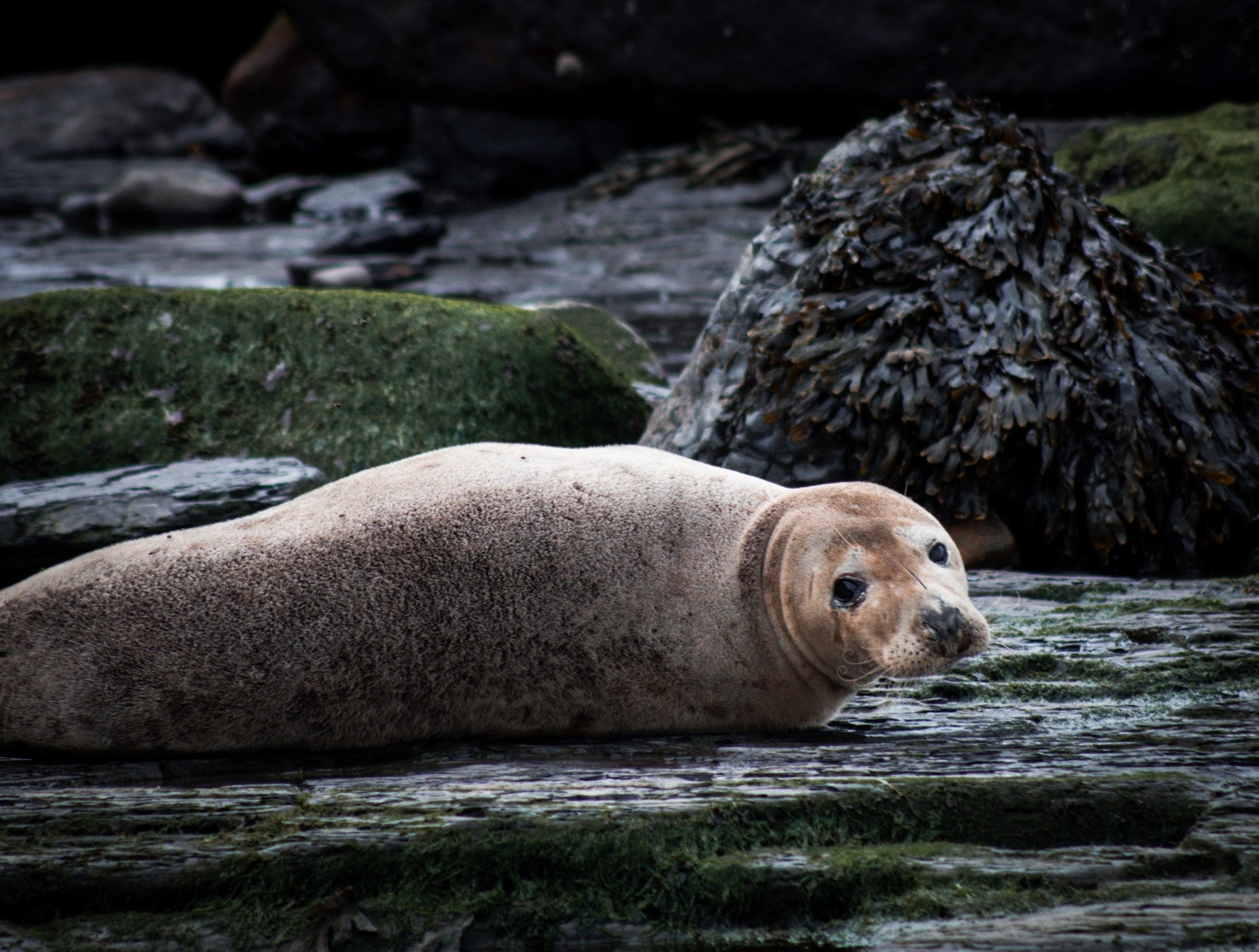532wAlong the rugged Yorkshire Coast, not far from Whitby, is Ravenscar Beach. This rocky beach is quiet and remote and if you can brave the steep path down, you’re in for a real treat. This is where a large colony of both common and grey seals live beneath the cliffs. Visiting them is a wonderful day out and in this guide you can find out when the best time to visit is, how to visit the Ravenscar seal colony safely and without disturbing them or their pups.
At a Glance
Difficulty: the walk is short but very steep on rugged paths on the way to the beach. Confidence on tricky terrain and good balance is needed if you want to get directly to the beach
Distance: 1 km each way
Total Ascent: 200m (all on the way back)
Est Time: less than an hour to the beach and back but allow time for stops and for watching the seals
Starting location: National Trust Visitor Centre at Ravenscar (YO13 0NE)
Dog friendly: No - not if you’re visiting the seals because dogs can scare and injure the seals.
The Ravenscar Seal Colony
On the cliffs below the little village of Ravenscar, around 300 common and grey seals along with their pups live their lives. If you visit at the right time, you have a great chance of seeing them basking in the sunshine on the rocks or swimming and playing slightly further out at sea.
You’ll hear (and smell) them before you see them and this adds to the excitement of seeing such an impressive site; hundreds of seals on the beach and the rocks with their pups really isn’t something you get to experience every day.

The Grey seal is the larger of the two UK seal species. Most of their time is spent hunting out at sea but when their full of food, they often head to the beaches to lie down and digest their food. These types of seals are found across the UK and are protected in Britain under the Conservation of Seals Act. In the early 20th century, their numbers dwindled to only 500 but it’s now thought there are more than 120,000 grey seals in the UK!

The grey seal colony can be spotted further out at sea (so don’t forget to take a good pair of binoculars) but some of the seals will just be lounging around at the base of the cliffs and on the rocks.

You’ll also most likely see common seals; these are the smaller ones but in complete contrast to their name, they are actually less common than the Grey seals! Also protected in Britain, they’re mainly found on the east coast of England and along the coasts of Scotland and Northern Ireland.

Although it’s respectful to not get close to them, you can still have a great view of both types of seals. There are some great viewpoints from the footpath down but if you go down to the beach, keep an extra special eye out for seals so that you can avoid them and not scare them.

When is the best time to see the Ravenscar seal colony?
During the months of June, July and November, you have the greatest chance of seeing seal pups. However, the seal colony is there all pretty much all year round so any time you visit you’re more than likely to see the seals lounging on the rocks or the beach or bobbing about in the water. Now that we're in Autumn, you might find yourself getting a bit chilly watching the seals so remember to wear your cosy Hit the Road hiking socks!
Low tide is often the best time to see seals relaxing on the rocks.
During high tide they will often be harder to spot as they’ll be out swimming and hunting at sea.
To find the next low tide at Ravenscar, check out this tide chart for the area.
How to view the seals safely without disturbing them
Seals are incredibly shy animals and it’s easy to disturb them. It’s really really important to not get close to any seals, especially the mothers as if they get scared they can abandon the pups on the beach, missing feeding times and disturbing their normal routine.
There was recently an article in the news about a tourist throwing rocks at a seal (for what reason, who knows) which you can read here. Remember, this is not the way to behave around these beautiful animals, especially in their own habitat.
Seals are curious creatures but also easily frightened. Here’s how to view seals without causing disturbance;
- keep your distance - don’t walk right up to them and give them a wide berth.
- Staying around 50m as a minimum away from them is recommended
- view them with a pair of binoculars or a camera with a good zoom
- keep dogs well away from them. Better yet, don’t take your dog with you if you’re going to view the seals at Ravenscar
- don’t try to feed them anything
- avoid staying in their company for too long
- if a seal raises its head and looks directly at you, you’re too close - back away slowly and quietly
- Be as quiet as possible - don’t shout
Where do you park to see the Ravenscar seal colony?
There’s lots of free street parking in Ravenscar particularly on Raven Hall Road.
Is there public transport to Ravenscar?
Yes! There is one public bus that serves Ravenscar.
The number 115 runs from Scarborough to Ravenscar and takes approximately 45 mins.
You can find the timetable here.
Are there facilities at Ravenscar?
Yes! Ravenscar has public toilets and a National Trust visitor centre and cafe.
Scarborough also has a train station so the Ravenscar seal colony can be visited using public transport relatively easily.
How long is the walk to see the Ravenscar seal colony?
The walk is relatively short at less than 1km each way however, don’t underestimate the steepness of the cliff path. Although downhill all the way, getting back up along the cliff path is a challenge. It’s a lot of ascent in one go and some sections are loose. This being said, if you are more confident, this shouldn’t cause much of a problem.
Download the route from the OS map app here.
1. With the National Trust Visitor Centre infront of you, head right down a rocky track that heads towards the golf course. Follow this track downhill until it bends left and there is a wooden signpost directing you across the grass.
2. Follow the path across the grass towards the cliffs until the path gets narrower.
3. Follow the cliff path as it winds further downhill. Watch out here as there is some loose rock and it gets slippy in or just after wet weather.
4. The final section of the path takes you straight onto the beach. This section is more challenging and steeper. Once on the beach you can head left or right along the beach and rocks. Remember not to get too close to the seals!
Komoot App
Have you ever tried Komoot? Komoot allows you to access routes planned by others or plan your own which you can then download to your phone to follow while you are out. Komoot is free to join and access and you can find the route for his walk here.
What else is there to do in and around Ravenscar?
As well as seal spotting, Ravenscar Beach is known for its abundance of fossils. They aren't as common as other beaches along this coast but it's always worth a look.
Ravenscar is only a small village but if you're a history buff who has a keen interest in WW2 then why not head to the old radar station which can be found by following the cliff top path.
Whitby and Robin Hood's Bay, slightly further north of Ravenscar, are also worth exploring. For a real adventure, you could follow the Cleveland Way from Ravenscar all the way to Robin Hood's Bay. This section of the Cleveland Way actually runs along the beach but you can only do this at low tide.
Finally, if you're in the area for longer than a day, why not check out another walk along this coast I posted about slightly further south at Bempton Cliffs. You can explore old sumggler's caves, shipwrecks and see one of the UK's largest sea bird colonies. Check out that walk here.
For additional UK outdoor adventures, wild swimming, hiking routes and more, check my other blog posts here on MY URBAN TRAIL and follow me @Wild_0utdoors on Instagram.
Happy adventuring!
Izzy




